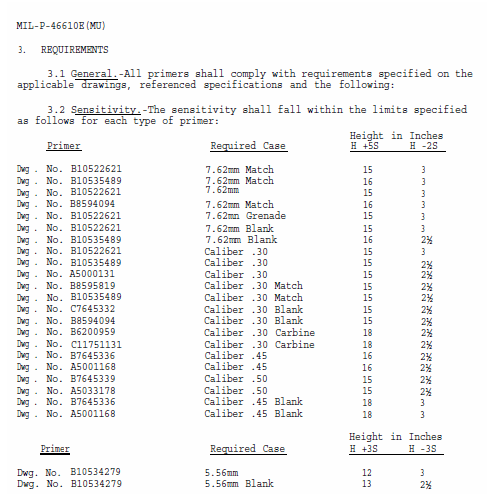The CCI #34 and #31, the Federal GM205MAR, and the TulAmmo KVB7.62 NATO and KVB5.56M NATO primers are all made to military sensitivity specs. These are tested for firing pin energy in a fixture which holds a properly primed case upside down in a shell holder with a floating firing pin resting on the primer, then dropping a 3.94 ounce weight on it from different heights in inches. This is also called the H test. The table below shows military values. If you are ambitious about testing, you could build your own H-test apparatus and report the 50% failure to fire drop height for comparison. Those of us too lazy to do it will be pleased to applaud you and copy the results.
If you want to study ignition energy, that can be done by making a primer-fired ball-bearing gun and comparing the velocities achieved.
If you want to study ability to ignite, then a couple of standard loads, one with easy to ignite powder like 4198 and one with hard to ignite powder, like H380, and measuring relative velocities produced by each and standard deviations produced, should give some idea. I understand there is fancy analytic equipment the military has that studies gas volume, flame temperature and heat output directly, but that's going to be expensive to build and probably expensive to maintain.
To update the original thread posts, I put in my own copy of a current link to the article in the post where I first mentioned it. The 0.003-0.005" below flush mentioned in it seems to work out for most commercial brass as-produced. The cup does not hit the bottom, as most have anvil feet sticking up higher than that would require and they would be over-crushed when the primer got there. What you want to do, as the article mentioned, is "set the bridge" correctly. The bridge is the amount of primer material between the inverted tip of the anvil and the inside bottom of the primer cup. Old military specs (McDonnell-Douglas report from the mid-70's) refer to the act of putting adequate crush on the priming mix as "reconsolidation" of the primer. It is is not set correctly at the factory because the factory knows there will be a primer pocket depth tolerance. The original version has Remington and Olin both recommending 0.002"-0.006" of crush of the anvil into the primer as optimal. A later (early 80's) versions of the same document has NOIH recommendations of 0.002"-0.004" based on their testing. This fits with the recommendation Federal gave John Milosovich for the 1995 Precision Shooting Reloading Guide, which was 0.002" for their small rifle primers and 0.003" for their large rifle primers. Federal did not provide a tolerance.
K&M makes a tool called the
Primer Gauge tool that allows you to measure exactly how much you are setting the bridge by zeroing simultaneously on the depth of each individual case primer pocket and on the height of the individual primer, including anvil, that you will seat into it. Others designed to control primer seating depend either on feel or on fixed depth settings below flush with the case head, in which case you must uniform pocket depth for the best results.

